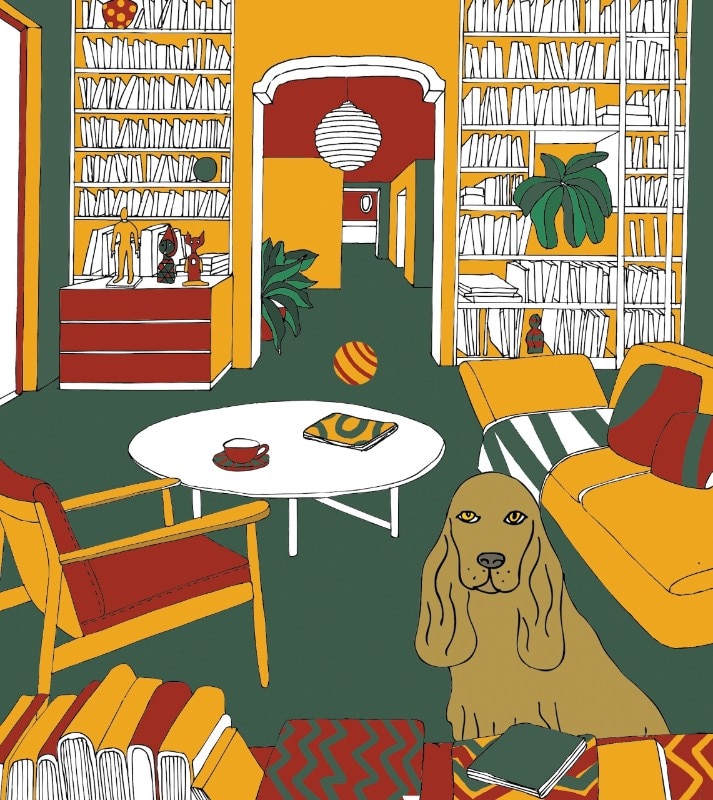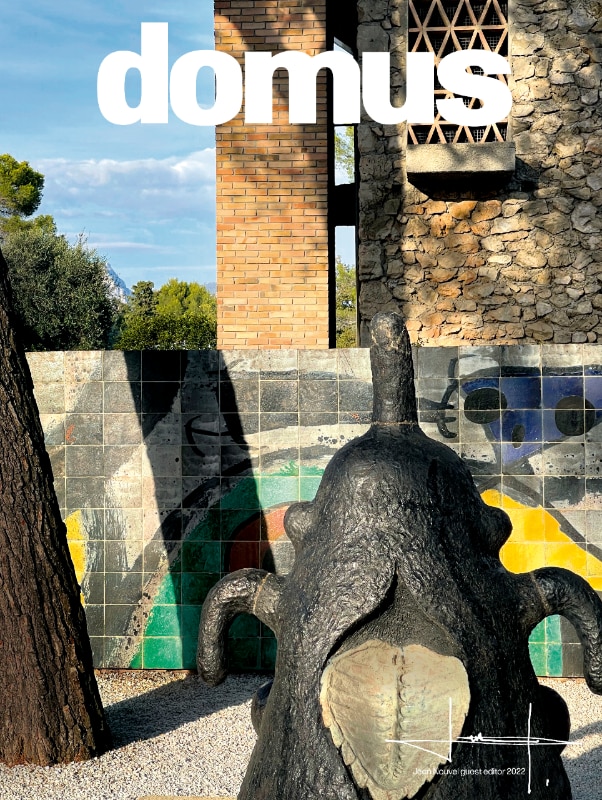The January issue of Domus 1064 inaugurates the new year by identifying the character as the leitmotif of the coming months of the magazine. In his first Editorial as Guest Editor, Jean Nouvel emphasizes the fundamental role of architectural practice in defining expression. For him, the social and legitimate role of architecture, and therefore of the architect, thus lies in the expressiveness of the place, in deepening it, imagining it, and concretely inventing a life that brings out the spirit of the place. “I hope,” writes Nouvel, “that Domus may crystallise its evocative power, expressing sensations, sensibilities, anomalies and exceptions through its choice of architecture or objects, and endeavouring to convey the genuine impressions experienced when
faced with those chosen subject.”
Cover of Domus 1064. The Goddess (1963) and The Wall (1968), Fondation Maeght, Saint-Paul de Vence, France. Photo Jean Nouvel
Following in the Essays is the French art critic and curator Jean de Loisy, who speaks of the importance of the unexpected in the process of artistic creation, a necessary element in contemporary monotony. The architect Gianluca Peluffo tells us about the parable of the Vitrolles Stadium designed by Agence Rudy Ricciotti in 1994, closed after only four years due to an explosive attack. The municipality has never found a way to recover and reuse the monolith, and the Stadium still remains as a fracture in the city through its massive and brutal force.
The first part of the Architecture section is dedicated to Miró’s Labyrinth at the Fondation Maeght in Saint-Paul de Vence, an open-air exhibition route that is articulated as a white line – its Ariadne’s thread – and that develops by following bare nature. “It is a path that follows the slopes and levels, being careful, above all, not to change them, which would be not so much a crime as nonsense. It gathers the waters as it marries the sky,” writes Francis Marmande. “Stunning, to think about it, this Labyrinth by Miró, yet another re-edition of one of the most fundamental, most prolific myths of humanity, a myth that is said to date back, well before the Greeks, to the Bronze Age.”
This is followed by Christo and Jeanne-Claude’s posthumous project for the Arc de Triomphe in Paris, wrapped with 25,000 square meters of silver-blue recyclable polypropylene fabric and 3,000 m of red rope. Stopping in the French capital, Donatien Grau tells us about the project to reuse the La Samaritaine department store, where Japanese studio SANAA’s transformation of the façade on rue de Rivoli is a convincing testimony to the power of diaphanousness in architecture, radicalizing this shift towards a non-monumental grandeur. Following, HW Studio’s recent design for a vacation home nestled in a conifer and oak forest near Morelia, Mexico.
The pages of the Art section are dedicated to the Palais de Tokyo where, after the critical restoration work carried out by Lacaton & Vassal, “Natures Mortes” by Anne Imhof could be the first project to tackle all the layers of history of this place with such a level of ambition and precision. For Design, architect Martine Bedin – one of the founders of the avant-garde group Memphis – describes the furniture and lighting project Ronan & Erwan Bouroullec developed for the major restoration project of the Bourse du Commerce in Paris, now home to the Pinault collection.
We close the issue with the Reaction section, where Fabrice Lextrait writes about the importance of cultivating community spirit. “Today, the imperative of architects, composers, filmmakers, authors or artists is no longer to create and build ‘for’, but to create and build ‘with’. This revolution is naturally part of the process of integration with the context, strengthening and deepening the work with users, the public and the citizenry.”

This month’s Diario, pages dedicated to current events, is opened by the section Points of View, where a dialogue between historian Irénée Scalbert and architect Philippe Rahm delves into the antithetical relationship between architecture and nature. However, a revision of this relationship has been triggered by the climate crisis, a phenomenon to which the profession is giving differing responses, sometimes limited to technical solutions. For Opinioni, Ugo La Pietra writes about places of waiting: “our life, both individual and collective, is constantly characterized by the category of waiting, a fact that is not only mental but also physical, i.e. linked to real places”. This is followed by the project for the Music School of Bressanone. Focusing on sharing space and functions, the Carlana Mezzalira Pentimalli studio designed an open music school that dialogues with the city its tradition. For Company Stories, Fabrizio Cameli tells the story and mission of his company, founded in 2004 and to become a joint-stock company in 2021, to have an increasingly widespread control of the supply chain. Finally, at the end of the issue, writer Andrea Bajani describes the house, on the second floor of a late 19th-century Genoese building that he lived in for a couple of months 20 years ago. “A hundred square feet, ceiling bookcases crammed with books,” where he wrote his most famous novel If You Consider the Faults.
This month, you will also find as an insert the story of what happened during the fourth edition of domusforum, the day dedicated to the future of cities that took place on November 24 at the Leonardo da Vinci National Museum of Science and Technology in Milan. Planetary consciousness, education, design-thinking, and co-participation in the innovative effort: these are the keys to the future that emerged from the confrontation between the different areas of knowledge gathered on the domusforum stage.

Visual harmony and aesthetic
Now, more than ever, interior design is a balance of form and function, a dialogue between architecture, materials and finishes that transform and make the most of the space involved.





























